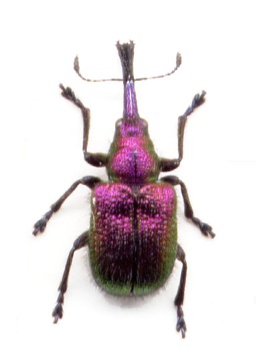Pests
Rhynchites bacchus L. - Peach Weevil.
Systematic position.
Class Insecta, order Coleoptera, family Attelabidae, genus Rhinchites. Easily differs from R. giganteus Kryn. by smaller body size and darker color.Biological group.
Orchard pest.Morphology and biology.
Body length, 4.5-6.5 mm. Bright purple color with strong metallic shine. Body covered with long hairs, black on upper side and light-brown on under side. Rostrum cylindrical, widened in apical part; external margin of mandible with few denticles. Eyes oblong-ovate, moderately strong convex. Scutellum big, rectangular. Adults feed on buds, flowers, soft fruits. Eggs are laid into a special chamber in fruit. Oviposition continues from the end of May to August, when beetles die. Fertility is 250 eggs, which are milky-white or yellowish. Eggs develop in 5 to 9 days. Cannibalism is typical of the species, when several larvae develop at the same time inside one fruit. Larvae feed mainly on decaying pulp of fruits, sometimes on seeds. Body length at the last instar larva reaches a length of 9 mm. After their development during 20-55 days the larva goes in the soil and makes a globular chamber for pupation at a depth of 2-3 cm. Pupae are white or yellowish. Pupa development lasts 10 to 13 days, when young beetles leave chamber but do not emerge on the soil surface until 10-40 days, from August to October. The young beetles eat buds and young shoots in the autumn.Distribution.
Inhabits Europe, northern Africa, and northern Iran. In the former USSR it is widely distributed in Ukraine, Crimea, in middle and southern regions of the European part of Russia and in the Caucasus. Northern border of area coincides with June's isotherm 20°C. It is known from Uzbekistan and Turkmenistan by a few specimens only.Ecology.
The beetles appear in March-April after hibernating, at the same time plants emerge from dormancy. Female chews through fruit stem after laying eggs, resulting in the fruit rotting and falling. Adults hibernate under the bark and between fallen leaves. Some of the last instar larvae hibernate in the soil chamber too. Diapause of these larvae continues before pupation at the end of the next summer. Woodpeckers, titmouses and carabid beetle Calosoma inquisitor L. use adult Peach Weevils for food. Larvae are parasitized by Pimpla calobata Grav., Calyptus testaceipes Grese, Bracon rhynchiti Grese, and also by the fungus Beauveria bassiana.Economic significance.
The most dangerous species for plum, apple, and apricot. A pest of Prunus Spinousus, cherry, and pear. Fruits damaged by the Peach Weevil are often infected by moniliosis (Sclerotinia fructigena) that is distributed by adults of the Peach Weevil. 30 to 40 pairs of adults per plum-tree can destroy the entire yield. Burning-up of the plant residues in the gardens, picking drop and mummified fruits from the trees, autumn plowing between the tree rows are important preventive control measures against the Peach Weevil.Reference citations:
Grossgeim N.A. 1928. Rhynchites bacchus L. Proceedings of horticultural and truck farming station in Mleev. Mleev Experiment Station: NKZS-UkrSSR. N.10: 143. (In Russian)Kryzhanovskii O.L., ed. 1974. Pest insects and ticks of agricultural plants. Leningrad: Nauka. V.2: 335. (In Russian)
Savkovskii P.P. 1951. Biology of Peach Weevil in Ukraine and control measures. Collection of works on plant protection. Ukrainian Institute of Horticulture. Kiev & Kharkov: Gos. Izd. Selskokhoz. Lit. N.32: 51-83. (In Russian)
Ter-Minasyan M.E. 1950. Roller-weevils (Attelabidae). Fauna USSR. Insecta-Coleoptera. M oscow & Leningrad: AN SSSR. V.27(2): 231. (In Russian)


